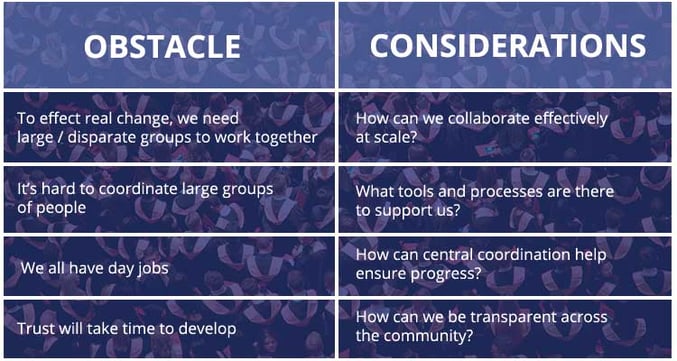- What do you do when the problem you face is overwhelming in its complexity?
- What do you do when the experts you need are in every corner of the world?
- What happens when no individual or group has all the answers?
These are just some of the questions that a set of principles, entitled ‘Collective Impact’, helps to address. These big questions include some of the biggest challenges our world faces, and that affect huge numbers of us. Yet, year after year, we see little progress.
An article in Stanford Social Innovation Review defined ‘Collective Impact’ as:
“…the commitment of a group of important actors from different sectors to a common agenda for solving a specific social problem.”
I’d like to consider a key social problem that’s critical to all institutions across Education.

How can we get more underrepresented communities to study STEM subjects?
This was the question I posed as part of my keynote presentation at the NSF INCLUDES Conference in January 2017. STEM is shorthand for Science, Technology, Engineering and Mathematics. The challenges associated with this issue are complex and many in number, they are both social and practical, no single community or institution could provide a complete solution.
Over the two-day conference, the 200 participating educators shared many amazing experiences on local projects that addressed slices of the challenge within specific minority communities.
As attendees shared their stories, there were three striking commonalities:
- A huge amount of passion for the topic;
- Most people weren’t dealing with a unique use-case, but instead reflected other use-cases elsewhere across the country;
- A struggle to make the significant impact they really wanted to see.
The attendees had diverse backgrounds: K-12 educators, Community Colleges, prestigious Higher-Education establishments – all addressing one or a small number of specific minority groups.
I shared an idea with the attendees. A vision of what could be done, by taking advantage of Collective Impact principles and processes, fine-tuned over decades in the private sector, to address: Collective Intelligence. You can discover a groups Collective Intelligence by bringing together diverse perspectives and asking them to collaborate on a common need. The most tangible and common examples come from online idea campaigns, focused on developing new innovations and efficiency improvements.

Let’s first consider what makes up a collective impact initiative:
- A common agenda: Shared vision, a common definition of the problem, and a forum for discussing differences.
- Shared measurement systems: Creating consistency around measurement and reporting; transparency to help the group hold each other accountable.
- Mutually reinforcing activities: Each group needs to play to its strength; an acceptance that everyone has a role to play; transparency over what each group is doing
- Continuous communication: Use web-tools to keep the channels of communication open; transparency of communication helps build trust & a common vocabulary
- A ‘backbone’ support organization: Responsible for coordination; dedicated staff who can plan, organize, coordinate, measure and report; to support effective decision making.
This sounds great in theory, but we must also consider the practical obstacles when it comes to implementing such a program.

After 15 years of helping corporations and government tap into their collective intelligence, I was fascinated to learn that the challenges and considerations are the same. Identical in fact.
It therefore seems reasonable to project, that if we can apply collective intelligence solutions and thinking to problems that require collective impact, perhaps we can make a difference on the big social problems of our age.
I began to investigate examples of collective intelligence which addressed social problems. They were limited in number, but they were all great examples of collective impact initiatives – just without the name.
- I discovered a company that makes commercial water pumps and used these principles to innovate their products to reduce maintenance issues in Africa.
- NGO’s engaging global experts in water to help address drought challenges in Australia.
- An insurance company trying to reduce injuries to children rather than just insuring against the risk.
- A University engaging 60,000 employees, faculty and students, in innovating the way they work together for the greater good.
I’d like to consider what all these programs had in common.
- A clear vision for what they want to achieve.
- An understanding by all parties on what ‘good’ should look like and how they’ll measure success and progress.
- An acceptance that no small team or individual can solve the problem. There’s a need for diverse perspectives to be brought together.
- A process for on-going communication to keep everyone briefed on progress and next steps.
- One organization that took ownership of coordination, planning, and decision-making processes.
They were all collective impact programs, using online collaboration tools and processes, to discover their own collective intelligence for the purposes of growth and efficiency.
So here is my big idea. Why can’t we use this same approach to resolve social challenges? Why can’t we use this same approach to coordinate all the passionate educators I met to work together on getting more minorities into STEM subjects.
All we need to do is try.
Here are my tips on how to make this work:
- Get support for a shared vision. Unless we all have the same goal, we cannot succeed.
- Be prepared to ask for help from other experts. There are people out there that have done it before.
- Use online tools to deal with the challenges of scale and location.
- Deadlines will help drive behavior. Don’t be frightened to set them, they’re even more important when people are busy.
- Feedback keeps people engaged, so communicate progress and next steps.
- Ask for a backbone organization to coordinate activities.








